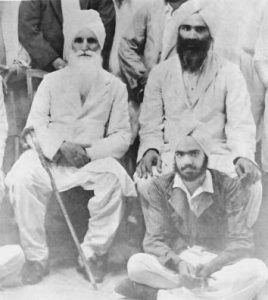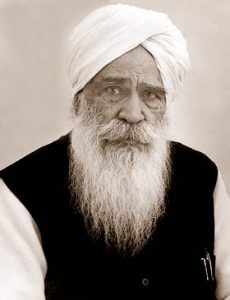
Param Sant Kirpal Singh Ji (1894 - 1974)
Kirpal Ji was born in India, in a simple rural house, in the western part of Punjab which now belongs to Pakistan. He earned his living as a government officer until his retirement and then he moved to Delhi where he founded his spiritual School “Ruhani Satsang” with its headquarters at “Sawan Ashram”.
Kirpal Ji's basic teachings consist in establishing contact with God into expression Power, called Word in the Bible, Naam, Shabd, Om, Kalma etc. in the other scriptures. The discipline of universal character taught by him is at the base of the spiritual experience which gave origin to all the main religions that have resisted the trials of time. It has been defined the Path of the Masters (Sant Mat), Meditation on the Divine Word or Yoga of the Sound Current (Surat Shabd Yoga).
Kirpal Ji was the President of the World Fellowship of Religion, an organization recognized by UNESCO which had representatives from all the main religions of the world. He wrote numerous books, many of which have been translated into numerous languages
 From youth he undertook a spiritual seeking which lead him to various sufis, yogis and mystics, but he never accepted any of them as a Master, continuing to pray to God to obtain a divine inner manifestation. In 1917 his prayers were answered: in fact, he began to see during his meditations the radiant form of a figure of noble aspect k2who he supposed was Guru Nanak, founder of the Sikh religion. In 1924 he met Hazur Sawan Singh, the famous Saint of Beas, in his Ashram on the banks of the Beas River, and in him he recognized the Luminous Form that he had seen during the seven previous years. He was initiated into the spiritual discipline by Hazur, and from then on he dedicated the rest of his life to reaching the summits of Spirituality.
From youth he undertook a spiritual seeking which lead him to various sufis, yogis and mystics, but he never accepted any of them as a Master, continuing to pray to God to obtain a divine inner manifestation. In 1917 his prayers were answered: in fact, he began to see during his meditations the radiant form of a figure of noble aspect k2who he supposed was Guru Nanak, founder of the Sikh religion. In 1924 he met Hazur Sawan Singh, the famous Saint of Beas, in his Ashram on the banks of the Beas River, and in him he recognized the Luminous Form that he had seen during the seven previous years. He was initiated into the spiritual discipline by Hazur, and from then on he dedicated the rest of his life to reaching the summits of Spirituality.
Already at the beginning of the 1930s Hazur Baba Sawan Singh would cite his name to those who asked if he had a disciple who had made great progress. In the same years, on inspiration from his Master, he began writing the “Gurmat Siddhant” (The Philosophy of the Masters), a monumental spiritual work in two volumes in the Punjabi and Urdu languages. It was published, upon request by Kirpal Singh, under the name of Hazur Sawan Singh, starting from 1935, and then edited in English in the 1960s in five volumes.
 In the morning of 12 October 1947 Hazur Sawan Singh called his favorite disciple Kirpal Singh and entrusted him with the work of continuing his spiritual mission after him. The next month Hazur approved the project of the spiritual School presented to him by Kirpal, the Ruhani Satsang (School of Spirituality or Science of the Soul). At the end of a brief illness, on 2 April 1948 Hazur Sawan Singh left his mortal body.
In the morning of 12 October 1947 Hazur Sawan Singh called his favorite disciple Kirpal Singh and entrusted him with the work of continuing his spiritual mission after him. The next month Hazur approved the project of the spiritual School presented to him by Kirpal, the Ruhani Satsang (School of Spirituality or Science of the Soul). At the end of a brief illness, on 2 April 1948 Hazur Sawan Singh left his mortal body.
After the passing of his Master, Kirpal went to Rishikesh at the foot of the Himalayan Mountains, where he spent the next five months in an almost continual state of samadhi, or absorption in God.
At the end of this period of intense meditation Kirpal Singh received an inner command from his Master: “Return to the world and bring my children back to me”. He moved to Delhi, where people from Punjab were looking for refuge because of the division from Pakistan: there he began his spiritual and humanitarian mission, which would have made him one of the greatest Masters of all time.
On 26 August 1972, Kirpal Singh conducted his third and final tour of the West, where he received and instructed more than 2000 new disciples of the Path of Spirituality.
In 1957, Singh was elected the first president of the World Fellowship of Religions, an organization recognized by UNESCO, comprising representatives from all the major world religions. He held that position until 1971, and presided over four World Conferences.

In 1962, he became the first non-Christian to receive the Order of Saint John of Jerusalem (Knights of Malta) for his spiritual and humanitarian work. On this occasion he received the congratulations of India’s prime minister, Jawaharlal Nehru, and established a spiritual tie with him that continued with prime ministers Lal Bahadur Shastri and Indira Gandhi.
Param Sant Kirpal Singh Ji merged with the ONE on 21 August 1974. He was 80 years old.
Kirpal Singh Ji left behind a treasure trove of extensive collection of books on spirituality, including The Crown of Life (a comparative study of various religions and yogas); Prayer, Its Nature and Technique; Spirituality: What It Is; Godman (on finding a spiritual teacher or guru), and The Wheel of Life (on karma). PDF versions of Kirpal Singh Ji’s books are available in the Books Section in this site.

